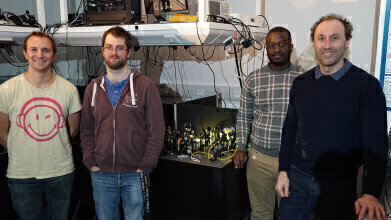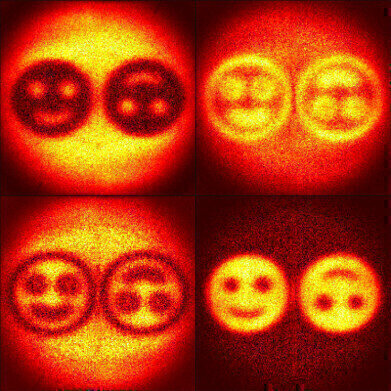-
 Pictured from left; Hugo Defienne, Ashley Lyons, Bievenu Ndagano and Daniele Faccio. (Credit: University of Glasgow)
Pictured from left; Hugo Defienne, Ashley Lyons, Bievenu Ndagano and Daniele Faccio. (Credit: University of Glasgow) -
 The team’s system combines four images to produce a three-dimensional hologram. (Credit University of Glasgow)
The team’s system combines four images to produce a three-dimensional hologram. (Credit University of Glasgow)
News & Views
Quantum Leap in Holography could Revolutionise Imaging
Feb 28 0202
A team of physicists from the University of Glasgow have found a way to use quantum-entangled photons to encode information in a hologram which could lead to improved medical imaging and speed the advance of quantum information science.
In classical holography two-dimensional renderings of three-dimensional objects are created when a beam of laser light split into two paths; one, the object beam, illuminates the holograph’s subject, with the reflected light collected by a camera or special holographic film. The second, or reference beam is bounced from a mirror directly onto the collection surface without touching the subject. The holograph is created by measuring the differences in the light’s phase where the two beams meet. The phase is the amount that the waves of the subject and object beams mingle and interfere with each other, a process enabled by a property of light known as ‘coherence’.
The Glasgow team’s new quantum holography process(1) also uses a beam of laser light split into two paths, however in their quantum version of holography, the photons never overlap with each other after passing through their respective targets. Instead, because the photons are entangled as a single ‘non-local’ particle, the phase shifts experienced by each photon individually are simultaneously shared by both.
The interference phenomenon occurs remotely and a hologram is obtained by measuring correlations between the entangled photon positions using separate megapixel digital cameras. A high-quality phase image of the object is finally retrieved by combining four holograms measured for four different global phase shifts implemented by the spatial light modulator on one of the two photons.
Dr Hugo Defienne, of the University of Glasgow’s School of Physics and Astronomy, is the paper’s lead author. Dr Defienne said: “Classical holography does very clever things with the direction, colour and polarisation of light, but it has limitations, such as interference from unwanted light sources and strong sensitivity to mechanical instabilities. The process we’ve developed frees us from those limitations of classical coherence and ushers holography into the quantum realm. Using entangled photons offers new ways to create sharper, more richly detailed holograms, which open up new possibilities for practical applications of the technique.
“One of those applications could be in medical imaging, where holography is already used in microscopy to scrutinise details of delicate samples which are often near-transparent. Our process allows the creation of higher-resolution, lower-noise images, which could help reveal finer details of cells and help us learn more about how biology functions at the cellular level.”
The University of Glasgow’s Professor Daniele Faccio, co-author and leader of the group which made the breakthrough said: “Part of what’s really exciting about this is that we’ve found a way to integrate megapixel digital cameras into the detection system.
“Many big discoveries in optical quantum physics in recent years have been made using simple, single-pixel sensors. They have the advantage of being small, quick and affordable, but their disadvantage is that they capture only very limited data about the state of the entangled photons involved in the process. It would take an extraordinary amount of time to capture the level of detail we can collect in a single image. The CCD sensors that we’re using give us an unprecedented amount of resolution to play with – up to 10,000 pixels per image of each entangled photon. That means we can measure the quality of their entanglement and the quantity of the photons in the beams with remarkable accuracy.
“The quantum computers and quantum communications networks of the future will require at least that level of detail about the entangled particles they will use. It puts us one step closer to enabling real step-change in those fast-developing fields. It’s a really exciting breakthrough and we’re keen to build on this success with further refinements.”
Their work was supported by funding from the Engineering and Physical Sciences Research Council (EPSRC), and the European Union’s Horizon 2020 and Marie-Curie Sklodowska Actions initiatives.
(1) ‘Polarization Entanglement-enabled quantum holography’, is published in Nature Physics.
More information online
Digital Edition
Lab Asia 31.2 April 2024
April 2024
In This Edition Chromatography Articles - Approaches to troubleshooting an SPE method for the analysis of oligonucleotides (pt i) - High-precision liquid flow processes demand full fluidic c...
View all digital editions
Events
Apr 28 2024 Montreal, Quebec, Canada
May 05 2024 Seville, Spain
InformEx Zone at CPhl North America
May 07 2024 Pennsylvania, PA, USA
May 14 2024 Oklahoma City, OK, USA
May 15 2024 Birmingham, UK

















